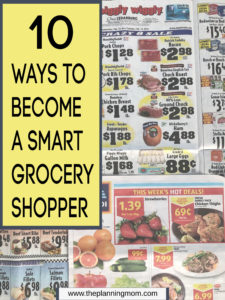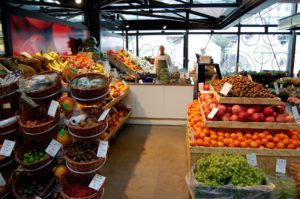
Is grocery shopping completely daunting to you? Grocery shopping can be an overwhelming task, especially if you are newer or struggle with the experience. It takes time to become a smart grocery shopper. I think back to my college days or just after and how much money I would spend on groceries. At times I would throw food out because it was expired and I had bought too much. That was over a decade now, and since I have learned how to be a smart grocery shopper.
Currently, I grocery shop weekly where I go to 1-4 stores depending on the ads, sales, and necessities. Start saving money and decreasing stress with my shopping techniques. These are all current things I do – so they have all been tried and tested. Implement these tips so you can become a smart grocery shopper too!
10 Ways to Become a Smart Grocery Shopper

- Be a consistent shopper. In my house I do all the grocery shopping. Since I always do it, I have gained lots of experience by shopping each week. Like with anything practice makes perfect. Good grocery shopping skills definitely can improve over time and it helps if you do it constantly. You learn where everything is located in the store which saves on time. You save more money because you learn what is actually a good deal.
- Join store memberships. Sign up to be a member at the grocery stores you shop at. This is usually free to join and takes 5 minutes to sign up. They usually give you a card to swipe each time you shop or can enter your phone number. Often you have to be a member to receive the store sales, deals, and coupons. In addition, you may receive special rewards or exclusive deals by being a member.
- Bring along the store ads. It is helpful to have the ads along when you grocery shop. You may need to recheck sales or show the clerk if an item rings up the wrong price. Click here for more about deciding where to grocery shop.
- Always shop with a list. A list will keep you organized to know exactly what to get at the store. A list helps you stick to your budget and not impulse buy items you do not need. In addition, without a list items can easily be forgotten. Without a list you typically end up buying more than you should. Click here for how to make an efficient grocery shopping list.
- Know your inventory. Track product usage at home and how long items last with your family. When you start a long term item write on the box/package the date you started it. Then you can track how long it took you to go through. This way you can see how many you should buy at a time when they are on sale. This can also help determine the size of an item you should buy. If you buy the large package but end up throwing half of it away it might have been cheaper to buy the smaller size. We all have items that we use a lot and others not so much. When these items go on sale I buy as many as I think we will go thru before they expire. By knowing what is in our fridge, freezer, and pantry we can better stock up during a good sale. For example, if shredded cheese is on sale I check how much cheese and which kinds I have in my fridge. I make the appropriate notes on my grocery list. Then I know how much and what kind to buy when at the store. When deciding what size of a product to purchase, think how fast you go through it.
- Buy what is on sale. It is simple. To save money only buy items when they are on sale. There are certain items I never buy unless they are on sale. To prepare for buying sale items think about how much you go thru of that item. After a while you learn what goes on sale and what rarely goes on sale. This helps determine how much you buy of what and when.
- Check expiration dates. When grocery shopping check the expiration date on what you are buying. Do not take any expired items as sometimes these are left on the shelf. Take the item with the newest date possible.
- Check the price per ounce/per item. This can typically be found on the price tag on the shelf or rack. It tells you the actual cost of a food item. From this you can determine which size or brand of an item to buy. For example, if i am buying taco shells and one kind is $2 for 10 shells the price tag would say 0.20 per shell. Another kind is $3 for 20 shells so it would say 0.15 per shell. The $3 pack of shells is cheaper per shell. By quickly glancing at this price tag you can save money as a smart grocery shopper. Sometimes larger/more of an item is cheaper – sometimes it is not. Furthermore, checking the tag can help you make healthier choices. For example, a bag of chips per ounce costs similar to a bag of apples. The apples are much healthier and will last about as long if not longer than a bag of chips.

- Buy generic products. Buy generic brand items instead of name brand items. Most of the time the generic brand is less expensive than the name brand. Sometimes you can save over 50% just by purchasing the generic brand of the same item. Most often the product is not much different either. You may even like the generic brand better. There are only a couple of products where I can tell the difference and prefer the name brand over the generic brand. Otherwise I always purchase the generic brand.
- Use coupons. Coupons can save you lots of money and even get the cost of items nearly free. Clip coupons and get a coupon book to stay organized. There are many different ways to get coupons. Click here for more on the essentials to couponing. Smart grocery shoppers go on double coupon days.
There are many things you can do to become a smart grocery shopper. Try incorporating these techniques into your grocery shopping routine next time you shop. Some of them may feel a bit awkward at first, but can quickly become a positive habit. Start saving loads of money and time today!
Leave a Reply